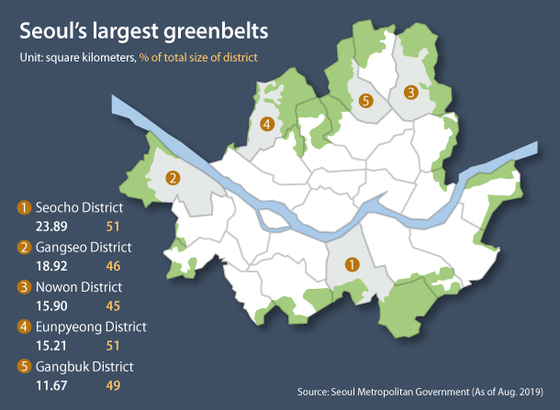Greenbelt-protected land may be developed
Despite the dire housing shortage in Seoul and a brewing property bubble, 150 square kilometers (58 square miles) sits virtually empty within the city. The government has its eye on these areas and is hoping to develop the land.One hitch: the verdant swathes are currently greenbelt. Greenbelt zones are protected areas where building is not permitted in order to bring open spaces to city centers.
The government is “open to the possibility of lifting the restrictions on greenbelt zones following a review, if necessary,” Finance Minister Hong Nam-ki said Tuesday.
Greenbelt conversion has frequently been seen as a way to address the country’s housing-supply shortage, but the Seoul Metropolitan Government has been against the idea, saying greenbelt-designated areas are supposed to be exempt from development in order to preserve and protect the natural environment.
According to the Ministry of Land, Infrastructure and Transport, there are 3,837 square kilometers of greenbelt zones total in Korea as of December 2019, about 4 percent of the entire country.
Korea’s greenbelt areas are divided into five grades, with first-level zones most valuable in terms of the environment. Third- to fifth-level greenbelt zones are the regions that have already been degraded.
The government’s intention is to lift the restriction on the third- to fifth-level of greenbelt areas and to build apartments there. Based on data from the Ministry of Land, Infrastructure and Transport, Seoul has about 29 square kilometers of third- to fifth-level greenbelt areas.

Seoul has about 150 square kilometers of greenbelt, or about 25 percent of the total in the country, including a 23-square-kilometer zone in Seocho District, southern Seoul. Seocho is about half greenbelt.
Gangseo District in western Seoul is home to an 18-square-kilometer greenbelt zone, which is 46 percent of the entire district. The Naegok-dong area of Seocho and Gimpo International Airport area of Gangseo are the best possibilities for development.
Gangnam District is home to a 6-square-kilometer greenbelt zone, while Eunpyeong District has a 15-square-kilometer greenbelt area. Gangbuk District has 11 square kilometers of greenbelt, Dobong District 10 square kilometers and Nowon District 15 square kilometers. These greenbelt zones, all in northern Seoul, take up over 40 percent of each district.
![Greenbelt zone in Naegok-dong in southern Seoul. [JOONGANG PHOTO]](https://koreajoongangdaily.joins.com/data/photo/2020/07/16/64918c89-7fd1-4b5a-b115-276dfdda852a.jpg)
Greenbelt zone in Naegok-dong in southern Seoul. [JOONGANG PHOTO]
“The Seocho and Gangnam District will be the best options for government as they are convenient for transportation, as well as basic amenities,” Choi Sun-ung, CEO of Korea Substitute Land Development, said. “The Eunpyeong, Gangbuk and Dobong areas have too many mountains nearby.”
Some experts say opening up the greenbelt zones will not help solve the country’s housing supply shortage.
“It is impossible to design a new town in Gangnam District when all the government’s real estate regulations are currently targeting the district,” one property developer said.
In 2009, when the Lee Myung-bak administration allowed for development in the greenbelt zones of Seocho and Gangnam, the prices of apartments there were about half of the other same-sized apartments in those districts.
At the time, an 84-square-meter flat in Prugio Apartments in Segok-dong, Gangnam District, cost about 340 million won ($280,000), which was about 60 percent cheaper than other same-sized apartments. Demand for the apartments was high, resulting in a rise of jeonse, or long-term housing rental deposit, prices.
“Aside from the greenbelt zones, it will not be easy for the government to find empty areas,” Park Won-gab, a real estate economist at KB Kookmin Bank said. “It would take a while to supply housing to citizens, but opening up the greenbelt zones can send a signal of the government’s determination to the market.”
BY CHOI HYUN-JU, CHEA SARAH [chea.sarah@joongang.co.kr]










with the Korea JoongAng Daily
To write comments, please log in to one of the accounts.
Standards Board Policy (0/250자)